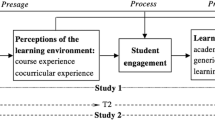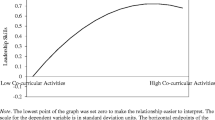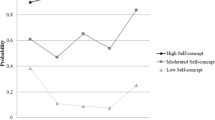Abstract
This study evaluated the feasibility of using students' self reports of the academic development and college experiences as proxies and policy indicators for a national assessment of undergraduate education. Results indicated that self reports of academic development should be used with care as proxies for a national test. Particularly important are issues of content overlap and differences in the measurement methods. Results from the second part of this study supported using self reports of college experiences as policy indicators to improve undergraduate education.
Similar content being viewed by others
References
Akaike, H. (1973). Information theory and an extension of the maximum likelihood principle. In B. N. Petrov and F. Csaki (eds.),Second International Symposium on Information Theory. Budapest: Akademiai Kiado.
Anaya, G. (1992). Cognitive development among college undergraduates. Unpublished doctoral dissertation, University of California, Los Angeles.
Association of American Colleges (1985).Integrity in the College Curriculum: A Report to the Academic Community. Washington, DC: Author.
Astin, A. W. (1993).What Matters in College? San Francisco: Jossey-Bass.
Baird, L. L. (1976a). Structuring the environment to improve outcomes. In O. Lenning (ed.),Improving Educational Outcomes (New Directions for Higher Education Series, no. 16, pp. 1–24). San Francisco: Jossey-Bass.
Baird, L. L. (1976b).Using Self Reports to Predict Student Performance. New York: College Entrance Examination Board.
Banta, T. W. (1991). Toward a plan for using national assessment to ensure continuous improvement in higher education. Unpublished manuscript, Center for Assessment Research and Development. Knoxville, TN. ERIC Document Reproduction Service No. ED 340 753.
Berdie, R. F. (1971). Self-claimed and tested knowledge.Educational and Psychological Measurement 31: 629–636.
Boyer, E. L. (1987).College: The Undergraduate Experience in America. New York: Harper & Row.
Byrne, B. M. (1993).Structural Equation Modeling with EQS and EQS/Windows. Thousand Oaks, CA: Sage.
Campbell, D. T., and D. W. Fiske (1959). Convergent and discriminant validation by the multitrait-multimethod matrix.Psychological Bulletin 56: 81–105.
College Board (1983).Academic Preparation for College: What Examinees Need to Know and Be Able to Do. New York: Author.
Cronbach, L. J., and P. E. Mechl (1955). Construct validity in psychological tests.Psychological Bulletin 52: 281–302.
Cudeck, R., and M. W. Browne (1983). Cross-validation of covariance structures.Multivariate Behavioral Research 18: 147–167.
Davis, T. M., and P. H. Murrell (1990). Joint factor analysis of the College Student Experiences Questionnaire and the ACT COMP objective exam.Research in Higher Education 31: 425–442.
Dumont, R. G., and R. L. Troelstrup (1980). Exploring relationships between objective and subjective measures of instructional outcomes.Research in Higher Education 12: 37–51.
Dunbar, S. (1991).On the Development of a National Assessment of College Student Learning: Measurement Policy and Practice in Perspective. Iowa City: University of Iowa, ERIC Document Reproduction Service No. ED 340 755.
El-Khawas, E. (1990).Campus Trends, 1990. Washington, DC: American Council on Education.
Elliott, E. (1991). Charge to participants. In A. Greenwood (ed.),National Assessment of College Student Learning: Issues and Concerns. Washington, DC: U. S. Government Printing Office.
Ewell, P. T. (1991). To capture the ineffable: New forms of assessment in higher education. In G. Grant (ed.),Review of Research in Education, vol. 17 (pp. 75–125). Washington, DC: American Educational Research Association.
Ewell, P. T., C. D. Lovell, P. Dressler, and D. P. Jones (1993).A Preliminary Study of the Feasibility and Utility for National Policy of Instructional “Good Practice” Indicators in Undergraduate Education. Boulder, CO: National Center for Higher Education Management Systems.
Fiske, D. W. (1982). Convergent-discriminant validation of measurements in research strategies. In D. Brinberg and L. Kidder (eds.),Forms of Validity in Research (New Directions for the Methodology of Social and Behavioral Science Series, no. 12, pp. 77–92). San Francisco: Jossey-Bass.
Friedlander, J. H. (1980). The importance of quality of effort in predicting college student attainment. Unpublished doctoral dissertation, University of California, Los Angeles.
Friedlander, J. H. (1991). The quality of students' educational experiences at Santa Barbara City College. Unpublished manuscript, Santa Barbara City College, Santa Barbara, CA.
Grossman, R. J. (1988). The great debate over institutional accountability.College Board Review 147: 4–6, 38–42.
Hartle, T. W. (1986). The growing interest in measuring the educational achievement of college students. In C. Adelman (ed.),Assessment in American Higher Education: Issues and Contexts (pp. 1–12). Washington, DC: U.S. Government Printing Office.
House, E. R. (1993).Professional Evaluation: Social Impact and Political Consequences. Newbury Park, CA: Sage.
Jöreskog, K. G. (1971). Statistical analysis of sets of congeneric tests.Psvchometrika 36: 109–133.
Jöreskog, K. G., and D. Sörbom (1989).USREL 7 User's Reference Guide. Chicago: Scientific Software.
National Education Goals Panel Resource Group on Adult Literacy and Lifelong Learning (1991). Adult literacy and lifelong learning. In National Education Goals Panel,Measuring Progress Toward the National Education Goals: Potential Indicators Measurement Strategies (pp. 81–98). Washington, DC: U.S. Government Printing Office.
National Governors' Association (1986).A Time for Results: The Governors' 1991 Report on Education. Washington, DC: U.S. Government Printing Office.
National Institute of Education Study Group on the Conditions of Excellence in American Higher Education (1984).Involvement in Learning: Realizing the Potential of American Higher Education. Washington, DC: U.S. Government Printing Office.
Osterlind, S. J. (1989).College BASE: Guide to Test Content. Chicago: Riverside.
Osterlind, S. J., and W. R. Merz (1990).College BASE Technical Manual. Columbia, MO: Center for Educational Assessment.
Pace, C. R. (1987).CSEQ Test Manual and Norms. Los Angeles: Center for the Study of Evaluation.
Pace, C. R. (1990).The Undergraduates: A Report on Their Activities and Progress in College in the 1980s. Los Angeles: Center for the Study of Evaluation.
Pascarella, E. T., and P. T. Terenzini (1978). Student-faculty informal relationships and freshman year educational outcomes.Journal of Educational Research 71: 183–189.
Pike, G. R. (1989). Background, college experiences, and the ACT-COMP exam: Using construct validity to evaluate assessment instruments.Review of Higher Education 13: 91–117.
Pike, G. R. (1992a). A generalizability analysis of the College Basic Academic Subjects Examination. Unpublished manuscript, Center for Assessment Research and Development, Knoxvillc. TN.
Pike, G. R. (1992b). The components of construct validity: A comparison of two measures of general education outcomes.Journal of General Education 41: 130–159.
Pohlmann, J. T., and D. L. Beggs (1974). A study of the validity of self-reported measures of academic growth.Journal of Educational Measurement 11: 115–119.
Porter, O. T. (1982). The role of quality of effort in defining institutional environments: An attempt to understand college uniqueness. Unpublished doctoral dissertation. University of California, Los Angeles.
Ratcliff, J. L. (1991).What Type of National Assessment Fits American Higher Education? Pennsylvania State University, University Park, PA. ERIC Document Reproduction Service No. ED 340 763.
Schmitt, N., and D. M. Stults (1986). Methodology review: Analysis of multitrait-multimethod matrices.Applied Psychological Measurement 10: 1–22.
Sugawara, N., and R. C. MacCallum (1993). Effect of estimation method on incremental fit indexes for covariance structure models.Applied Psychological Measurement 17: 365–378.
Terenzini, P. T., E. T. Pascarella, and W. Lorang (1982). An assessment of the academic and social influences on freshman year educational outcomes.Review of Higher Education 5: 86–110.
Terenzini, P. T., and T. Wright (1987). Influences on students' academic growth during four years of college.Research in Higher Education 26: 161–179.
Widaman, K. F. (1985). Hierarchically nested covariance structure models for multitrait-multimethod data.Applied Psychological Measurement 9: 1–26.
Williams, L. J., and P. J. Holahan (1994). Parsimony-based fit indices for multiple-indicator models: Do they work?Structural Equation Modeling 1: 161–189.
Wingspread Group on Higher Education (1993).An American Imperative: Higher Expectations for Higher Education. The Johnson Foundation.
Author information
Authors and Affiliations
Rights and permissions
About this article
Cite this article
Pike, G.R. The relationship between self reports of college experiences and achievement test scores. Res High Educ 36, 1–21 (1995). https://doi.org/10.1007/BF02207764
Issue Date:
DOI: https://doi.org/10.1007/BF02207764




